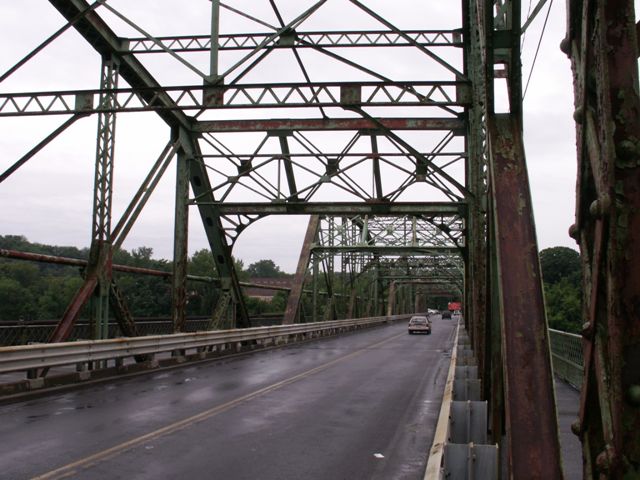We Recommend:
Bach Steel - Experts at historic truss bridge restoration.
BridgeHunter.com Phase 1 is released to the public! - Visit Now
Willimansett Bridge

Primary Photographer(s): Nathan Holth and Rick McOmber
Bridge Documented: July 13, 2008
Cabot Street (MA-116 and MA-141) Over Connecticut River and Railroad (Pioneer Valley Railroad)
Holyoke and Chicopee: Hampden County, Massachusetts: United States
Metal 10 Panel Rivet-Connected Pennsylvania Through Truss, Fixed and Approach Spans: Metal Deck Girder, Fixed
1891 By Builder/Contractor: R. F. Hawkins Iron Works of Springfield, Massachusetts and Engineer/Design: Edward S. Shaw of Boston, Massachusetts
Not Available or Not Applicable
173.0 Feet (52.7 Meters)
798.0 Feet (243.2 Meters)
26.9 Feet (8.2 Meters)
4 Main Span(s) and 2 Approach Span(s)
C1301213RDOT634

View Information About HSR Ratings
Bridge Documentation
View Archived National Bridge Inventory Report - Has Additional Details and Evaluation
View Massachusetts Historical Commission (MHC) Inventory Forms For This Historic Bridge
View Historical Biographies of Richard F. Hawkins
This bridge does not look like a bridge that was built in 1891. With a 26 foot wide deck, massive members, and riveted connections, it has more of a 1920s appearance. The only thing that makes it look as though it might be an older bridge is that it does not appear to conform to a state standard truss bridge plan. HistoricBridges.org double-checked the 1891 construction date on the plaque with some documents on the Internet, and this does indeed appear to be the original 1891 bridge. Assuming this bridge truly was built with riveted connections and pinned connections were not somehow converted to riveted connections at a later date, this is an extremely unusual and rare bridge. Riveted connections did not become popular especially in highway bridges until the early years of the 20th Century. Field riveting was difficult in the late 19th Century, and worse, the exact calculations needed for building the rigid trusses of a riveted connection truss was difficult, especially with a larger bridge that would undoubtedly tend to need to move and flex more as well. With its large Pennsylvania truss bridge spans, 1891 construction date, and riveted connections, the Willimansett is a very rare and significant bridge.
The bridge is currently programmed for a rehabilitation project. This is excellent news given the aesthetic qualities and historic significance of the bridge. As of 2008, the bridge had a 3% sufficiency rating. HistoricBridges.org (and apparently Massachusetts) both agree that this 3% sufficiency rating does not mean that rehabilitation is not possible, unwise, or unfeasible. Massachusetts has realized how often a sufficiency rating can be misleading and does not mean replacement is required. In other states where there does not exist a commitment to preservation, how many historic bridges have been needlessly demolished even with a much higher sufficiency rating such as 40%? Far too many!
R. F. Hawkins Iron Works of Springfield, Massachusetts was the builder of this bridge, and was named after Richard F. Hawkins.
![]()
Photo Galleries and Videos: Willimansett Bridge
Bridge Photo-Documentation
Original / Full Size PhotosA collection of overview and detail photos. This gallery offers photos in the highest available resolution and file size in a touch-friendly popup viewer.
Alternatively, Browse Without Using Viewer
![]()
Bridge Photo-Documentation
Mobile Optimized PhotosA collection of overview and detail photos. This gallery features data-friendly, fast-loading photos in a touch-friendly popup viewer.
Alternatively, Browse Without Using Viewer
![]()
Maps and Links: Willimansett Bridge
Coordinates (Latitude, Longitude):
Search For Additional Bridge Listings:
Bridgehunter.com: View listed bridges within 0.5 miles (0.8 kilometers) of this bridge.
Bridgehunter.com: View listed bridges within 10 miles (16 kilometers) of this bridge.
Additional Maps:
Google Streetview (If Available)
GeoHack (Additional Links and Coordinates)
Apple Maps (Via DuckDuckGo Search)
Apple Maps (Apple devices only)
Android: Open Location In Your Map or GPS App
Flickr Gallery (Find Nearby Photos)
Wikimedia Commons (Find Nearby Photos)
Directions Via Sygic For Android
Directions Via Sygic For iOS and Android Dolphin Browser
USGS National Map (United States Only)
Historical USGS Topo Maps (United States Only)
Historic Aerials (United States Only)
CalTopo Maps (United States Only)

